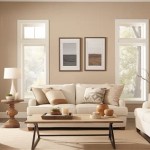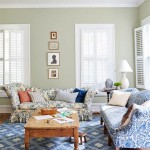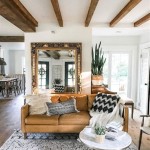How To Place Rugs In Living Room: A Comprehensive Guide
The strategic placement of rugs in a living room is a fundamental aspect of interior design, impacting both the aesthetic appeal and the functional comfort of the space. A well-chosen and appropriately positioned rug can anchor furniture, define zones, add warmth, and introduce texture and color, ultimately transforming a room from merely functional to visually engaging and inviting. Conversely, an improperly sized or positioned rug can disrupt the flow of the room, make it appear smaller or disjointed, and detract from the overall design.
Navigating the selection and placement of rugs, however, requires careful consideration of various factors, including room size, furniture arrangement, traffic patterns, and desired style. There is no one-size-fits-all solution, and the optimal approach depends on the specific characteristics of the space and the individual preferences of the homeowner. This guide aims to provide a comprehensive overview of the key principles and considerations involved in placing rugs in living rooms effectively.
Understanding Room Size and Rug Dimensions
One of the most crucial aspects of rug placement is selecting the appropriate size relative to the dimensions of the living room. A rug that is too small can feel lost and out of proportion, while a rug that is too large can overwhelm the space. The goal is to achieve a balanced visual composition that enhances the overall harmony of the room.
A common approach is to choose a rug that allows all the furniture in a seating area to sit entirely on it. This creates a cohesive and grounded look, visually defining the space as a distinct zone within the larger room. This approach works particularly well in larger living rooms where a generous rug can accommodate a substantial seating arrangement. The rug should extend beyond the perimeter of the furniture grouping by at least 12 to 18 inches to create a comfortable and visually appealing border.
Another option, particularly suitable for smaller living rooms or when budgetary constraints are a factor, is to choose a rug that anchors only the front legs of the furniture. In this configuration, the front legs of the sofa and any accompanying chairs rest on the rug, while the back legs remain on the bare floor. This creates a more open and airy feel, making the room appear larger. The rug should be wide enough to accommodate the front legs of all the furniture pieces in the grouping and long enough to extend a comfortable distance in front of the sofa.
A third alternative is to leave all the furniture completely off the rug, allowing the rug to function as a decorative island in the center of the room. This works best with smaller rugs and can be effective in highlighting a particular focal point, such as a coffee table or a fireplace. When using this approach, it is important to ensure that the rug is proportionally sized to the furniture and that there is sufficient exposed flooring around the rug to create a sense of balance.
Regardless of the chosen approach, it is essential to measure the living room carefully and to take into account the dimensions of the furniture before selecting a rug. Using painter's tape to mark out the proposed rug size on the floor can be a helpful way to visualize the impact of different rug dimensions before making a purchase. Standard rug sizes typically range from 5x8 feet to 9x12 feet or larger, but custom-sized rugs can also be ordered to meet specific requirements.
Considering Furniture Arrangement and Traffic Patterns
The arrangement of furniture within the living room plays a significant role in determining the optimal rug placement. The rug should complement the existing furniture layout and enhance the flow of traffic through the space. It is important to consider how people will move around the room and to ensure that the rug does not obstruct pathways or create tripping hazards.
In a living room with a clearly defined seating area, the rug should typically be centered under the main furniture grouping, such as the sofa and coffee table. This creates a visual anchor and unifies the space. If the seating area is asymmetrical, the rug can be positioned to balance the arrangement, perhaps by aligning it with the longest piece of furniture or by using it to define a specific zone within the larger area.
For open-plan living rooms that incorporate multiple functions, such as a living area and a dining area, rugs can be used to delineate these distinct zones. A large rug can define the perimeter of the seating area, while a separate rug can define the dining area. Choosing rugs with complementary colors or patterns can help to create a cohesive look while still visually separating the different zones.
Traffic patterns should also be taken into account when placing rugs. Avoid placing rugs in high-traffic areas where they are likely to be constantly walked upon, as this can lead to premature wear and tear. If it is necessary to place a rug in a high-traffic area, consider using a durable rug made from a material that can withstand heavy use, such as wool or a synthetic fiber. It is also advisable to use a rug pad to prevent the rug from slipping or sliding, which can create a safety hazard.
Furthermore, think about the placement of doors and doorways. Ensure that the rug does not impede the opening or closing of doors. A rug placed too close to a door can also be easily damaged by repeated friction. Leave adequate clearance between the edge of the rug and any doorways to prevent these issues.
Incorporating Style and Visual Appeal
Beyond the practical considerations of size and placement, the rug should also contribute to the overall style and visual appeal of the living room. The color, pattern, and texture of the rug can significantly impact the mood and atmosphere of the space. Consider the existing color palette of the room and choose a rug that complements or contrasts with it in a pleasing way.
A rug with a bold pattern or vibrant colors can serve as a focal point in the room, drawing the eye and adding visual interest. This can be particularly effective in a neutral-toned living room where the rug can provide a pop of color and personality. Conversely, a rug with a subtle pattern or muted colors can create a more calming and understated atmosphere.
The texture of the rug is another important consideration. A plush, high-pile rug can add warmth and comfort to the room, while a flatweave rug can create a more modern and streamlined look. The choice of texture should be guided by the desired aesthetic and the intended use of the rug. For example, a high-pile rug may be ideal for a cozy seating area, while a flatweave rug may be more suitable for a high-traffic area where durability is a priority.
The style of the rug should also be consistent with the overall design style of the living room. A traditional rug with intricate patterns and rich colors would be well-suited to a classically decorated room, while a modern rug with geometric patterns and bold colors would be a better fit for a contemporary space. There are countless styles of rugs available, ranging from traditional Persian rugs to minimalist Scandinavian rugs, so it is important to choose one that complements the existing décor.
Ultimately, the choice of rug is a personal one, and the goal is to select a rug that you love and that enhances the overall harmony and beauty of your living room. Take the time to explore different options and to experiment with different placements until you find the perfect solution for your space.

Place Rugs In Rooms How To Position Rug Placement

Place Rugs In Rooms How To Position Rug Placement

Living Room Rug Placement The Ultimate Guide Jessica Welling Interiors

11 Area Rug Rules And How To Break Them Http Www Houzz Com Ideabooks 222609 List R Living Room Placement Size Rugs In

Tips To Place Rugs In Living Rooms

Simple Design Tips 3 Ways To Place Your Rug Floorspace

26 Best Living Room Rug Ideas Area Design

Easy Guide To Area Rug Placement With Diagrams Rugplacement Arearug Living Room Rugs In

How To Place A Rug In Your Living Room

Q A With Rugs Usa Living Room Rug Placement In Large Outdoor Spaces And More The Roll Out








